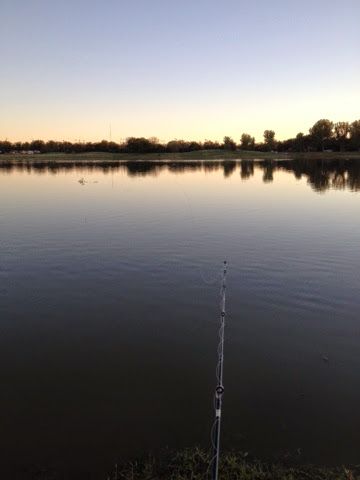In the fishing world, landing refers to getting the fish you've just hooked into the boat. I'm a bank fisherman, so in my case it refers to getting my fish up onto dry land. With bigger fish, landing requires technique and finesse. There are few things more heartbreaking than hooking a huge fish, seeing it come to the surface, and then losing it.
First let's talk about WHY fish are lost. There are generally two reasons. In some instances, the hook dislodges from the fish. In other cases, the line breaks. Either way, it stinks.
With regard to hooks, I prefer to give myself every advantage. So I use baitholder hooks. Granted, these hooks are designed to keep your bait from flying off during a cast.
Here's the thing. Those same little barbs that hold bait in place will also pierce the fish right along with the tip of the hook. Just as they prevent bait from sliding off the hook, they'll prevent your fish's mouth from sliding off the hook.
There's one other thing that will also help to prevent the fish from sliding off. Set the hook! Don't get carried away, but when the fish bites and you see the line go taught, give the pole a quick, firm jerk.
It will feel like your hook got stuck in something, and that's what you want. That something is the fish! Just make sure you jerk up towards the sky and not towards your body. This will ensure that you're jerking the hook up into the roof of the fish's mouth versus jerking it out of the fish's mouth, which is the last thing you want to do! For big fish, and particularly carp which have VERY tough flesh, I'll set the hook a second time.
As I've said before, I recommend Eagle Claw baitholder hooks, size 4. See my post on hooks for a picture. For tying the hook onto the line, I recommend either the fisherman's knot or the improved fisherman's knot. See my post on rigging a pole for a video demo.
Now that our fish is securely on the hook, we have to land it without breaking line. Contrary to popular belief, you don't need 20 lbs test line that looks more like rope. A 735 Marlin has been landed on 6 lbs test line.
I use 12 lbs monofilament line. Mono is the clear stuff that all but disappears in the water. It's thin enough to make knot tying easy, but strong enough to land the big fish. Below is a photo. Notice how the line disappears into the water.
Next up, the pole. Make sure you loosen up your drag (as much as half way) so that the fish can run with your line versus breaking it. Keep the pole at a 45 degree angle, as pictured below.
In addition to the drag on the line, the fish now has resistance from the pole. Your resistance is instantly doubled or even tripled by holding the pole at a 45 degree angle. That fish is going to tire out in half or even a third of the time.
Reel in gently but consistently. Never reel while the fish is exerting enough pressure to overcome the drag and pull line from your spool. That's a guaranteed line break!
When the fish stops running, start reeling again. As it tires, you'll be able to tighten up your drag and reel more effectively. That said, don't ever tighten your drag up completely. When you get the fish close to shore and it sees you, it will exert every ounce of energy it has to swim back out. This is literally make or break time!
So now we have this heavy weight to the shore. Never ever try to land a big fish by pulling up on the line. Have a net within arm's length. The net doesn't have to be huge. Mine is pictured below. The handle is just over two feet.
With regard to the net, you need to keep it away from your line. If you don't, the fish will wrap the line around the net handle, break line, get away, and leave you with a mess.
I recommend gently dipping the net below the water about two or three feet from the fish. Make sure as much slack as possible is out of your fishing pole line. By now your fish should be fatigued enough to oh so gently guide it into the net with the pole.
Make sure you keep the pole at a 45 degree angle, especially now. You're guiding the fish in versus reeling. Maximum resistance is still crucial.
For ultimate precaution, you can also carefully move the net, still submerged, towards the fish as you're guiding the fish toward the net. It's a meet in the middle kind of thing. Lots of work, I know. But is this not worth it?

















































